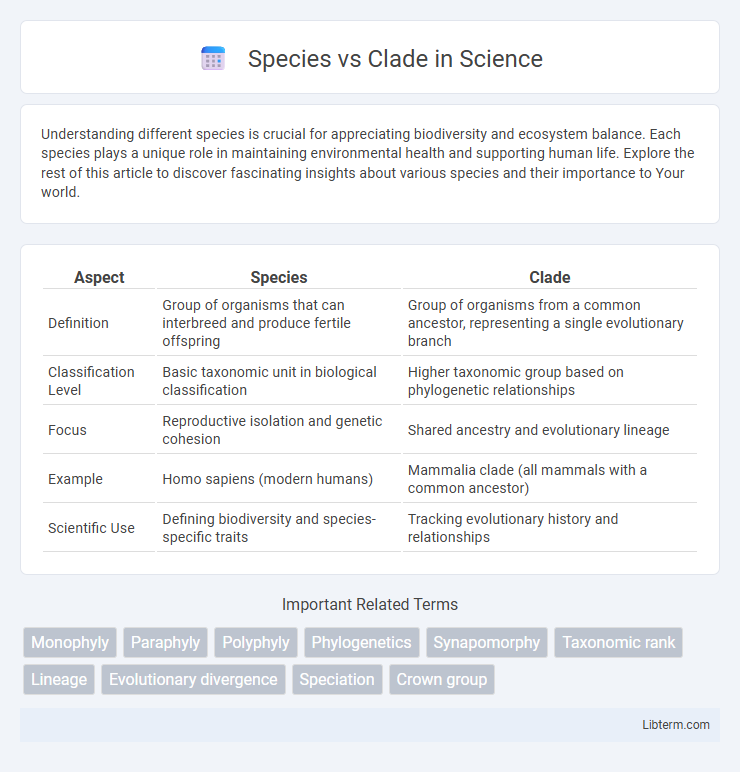Understanding different species is crucial for appreciating biodiversity and ecosystem balance. Each species plays a unique role in maintaining environmental health and supporting human life. Explore the rest of this article to discover fascinating insights about various species and their importance to Your world.
Table of Comparison
| Aspect | Species | Clade |
|---|---|---|
| Definition | Group of organisms that can interbreed and produce fertile offspring | Group of organisms from a common ancestor, representing a single evolutionary branch |
| Classification Level | Basic taxonomic unit in biological classification | Higher taxonomic group based on phylogenetic relationships |
| Focus | Reproductive isolation and genetic cohesion | Shared ancestry and evolutionary lineage |
| Example | Homo sapiens (modern humans) | Mammalia clade (all mammals with a common ancestor) |
| Scientific Use | Defining biodiversity and species-specific traits | Tracking evolutionary history and relationships |
Understanding the Concept of Species
Species represent groups of organisms capable of interbreeding and producing fertile offspring, defined by reproductive isolation and genetic similarity. Clades are monophyletic groups that include an ancestor and all its descendants, identified through shared evolutionary traits rather than reproductive criteria. Understanding species involves recognizing genetic boundaries and ecological niches, while clades emphasize common ancestry and phylogenetic relationships.
Defining Clades in Evolutionary Biology
Clades in evolutionary biology represent groups of organisms that consist of a common ancestor and all its descendants, forming a single branch on the tree of life. Unlike species, which are defined by reproductive isolation and genetic similarity, clades emphasize evolutionary lineage and shared derived traits (synapomorphies). Defining clades relies on phylogenetic analysis and genetic data to accurately trace ancestry and evolutionary relationships.
Comparative Overview: Species vs. Clade
Species represent the most specific level of biological classification, defined by the ability of individuals to interbreed and produce fertile offspring, whereas a clade encompasses a group of organisms that share a common ancestor, reflecting evolutionary relationships. Species are identified based on reproductive isolation and morphological similarities, while clades are determined through phylogenetic analysis using genetic, morphological, and molecular data. The distinction highlights species as discrete biological units, whereas clades illustrate the branching evolutionary lineage, essential for understanding biodiversity and evolutionary history.
Key Criteria for Identifying Species
Key criteria for identifying species include reproductive isolation, morphological similarities, and genetic distinctiveness, which differentiate species from one another by their ability to interbreed and produce fertile offspring. In contrast, a clade represents a group of organisms that share a common ancestor, identified through phylogenetic analysis and shared derived characteristics (synapomorphies). Species classification relies heavily on reproductive and genetic criteria, whereas clades emphasize evolutionary relationships and lineage-based grouping.
How Scientists Determine Clades
Scientists determine clades by analyzing shared derived traits called synapomorphies that indicate common ancestry among organisms. Molecular data such as DNA sequences and morphological characteristics are compared to construct phylogenetic trees, highlighting evolutionary relationships within clades. Cladistic methods emphasize monophyletic groups, ensuring each clade includes all descendants of a common ancestor.
Evolutionary Significance of Species
A species represents a group of organisms capable of interbreeding and producing fertile offspring, serving as the fundamental unit of biological classification and evolution. Its evolutionary significance lies in maintaining genetic continuity and enabling natural selection to act on populations, driving adaptive changes. Clades, by contrast, encompass all descendants of a common ancestor, highlighting broader evolutionary relationships rather than the specific reproductive boundaries that define species.
Evolutionary Significance of Clades
Clades represent groups of organisms that share a common ancestor, reflecting evolutionary relationships more accurately than traditional species classifications based solely on physical traits. Unlike species, which may be defined by reproductive isolation, clades emphasize phylogenetic lineage, tracing descent through genetic and morphological characteristics. This evolutionary significance of clades provides critical insight into the diversification and adaptation patterns across the tree of life.
Case Studies: Species and Clade Confusion
Case studies reveal frequent confusion between species and clade due to overlapping characteristics and evolutionary relationships. In the Darwin's finches example, species are traditionally classified by physical traits, while genetic analysis shows multiple clades indicating shared ancestry beyond apparent morphological differences. This misalignment challenges taxonomy, highlighting the need for integrated molecular and morphological data to accurately distinguish species from clades.
Implications for Biodiversity and Conservation
Species represent distinct biological units based on reproductive isolation, while clades encompass groups of organisms evolved from a common ancestor, reflecting evolutionary relationships. Prioritizing clades in conservation efforts preserves broader genetic diversity and evolutionary potential, unlike species-focused strategies that may overlook critical lineages. Understanding clade-based biodiversity enhances ecosystem resilience by safeguarding adaptive traits across multiple species, informing more effective conservation policies.
Future Research Directions in Species and Clade Classification
Future research in species and clade classification will leverage advanced genomic sequencing technologies to refine phylogenetic trees and improve accuracy in identifying evolutionary relationships. Integrating machine learning algorithms with large-scale biodiversity datasets will enable dynamic, real-time updates to taxonomy frameworks, enhancing resolution at both species and clade levels. Emphasis on environmental DNA (eDNA) sampling techniques will facilitate the discovery of cryptic species and obscure clade boundaries in diverse ecosystems.
Species Infographic

 libterm.com
libterm.com